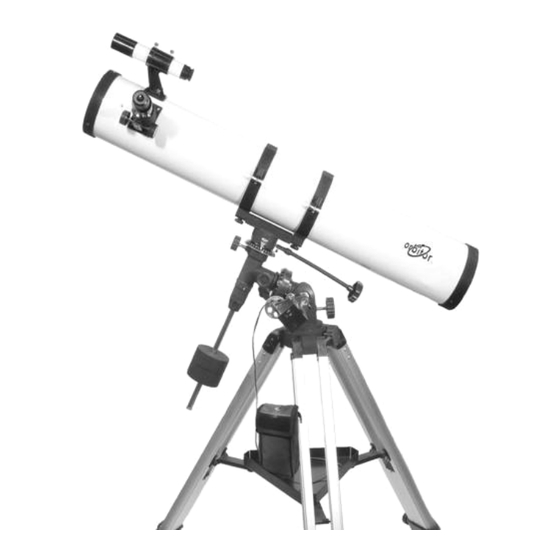
Subscribe to Our Youtube Channel
Summary of Contents for Citiwell Orbitor OR7500
- Page 1 OR6000 Series 4.5” Reflector Telescope (Model 7500) Instructions Owner’s Manual Made in China Manual Part # 262504 Revised September 2003...
- Page 2 Small parts. Not suitable for children under 3 years. WARNING! NEVER aim your telescope at the sun or even close to the sun! Instant and irreversible damage can occur, including blindness! Do not let children use any telescope without adult supervision.
- Page 3 Introduction Congratulations on your purchase of a new OR7500 telescope. With proper care and handling of your telescope, you will enjoy the pleasure of looking at nature’s wondrous sights through the eye of this instrument for many years. Your telescope has been designed to provide views of the moon’s craters, Jupiter’s major moons, and Saturn’s rings, in addition to dozens of galaxies, star clusters, and...
- Page 4 Keep your box for storage or in case you ever need to ship your telescope. 2) Extend the tripod legs, and lock each one at the desired height with the tripod leg adjustment knobs.
- Page 5 (See Fig. 6 and 7) (Fig. 6) 7) The counterweight balances your telescope and makes it easy to adjust and position. Hold the counterweight in your hand so you can see through the hole in the weight.
- Page 6 10) Remove the finder scope (with attached bracket) from the box. Slide the finder scope bracket into the finder scope base on the telescope. (See Fig. 15) Apply a gentle pressure until the finder scope bracket is firmly secured to the mount. (See Fig.
- Page 7 2X Barlow lens between the eyepiece and the focusing tube. (See Fig. 18) 13) The equatorial motor supplied with the OR7500 is designed to provide accurate tracking of celestial objects along the RA (Right Ascension) axis, thereby reducing the need for making constant manual readjustments in order to follow and keep a subject in view.
- Page 8 16) The motor is powered by 4 ‘D’ size batteries, housed in the battery pack supplied with your OR7500. To install the batteries, remove the power pack from its case as shown in Fig. 24. Open the battery cover and insert the batteries in the direction indicated.
- Page 9 FINDER SCOPE ALIGNMENT Since a telescope has a narrow field of view by design, it can be challenging to locate a particular star or planet. For this reason the telescope is fitted with a low-power, wide- field miniature telescope called a finder scope. Always use your finder scope to locate the object you want to view FIRST.
- Page 10 North Star. Loosen the altitude adjustment and suppot knobs (See Fig. 27) and raise or lower the angle of the telescope until you can see Polaris centered in the finder scope. Be certain that your finder scope is properly aligned.
- Page 11 10 mm of objective lens diameter. Magnification of around 335X or less is ideal for a telescope with a 114-mm diameter objective lens and is best for observing most celestial objects. A lower magnification power and a wider field of view are advisable for observing galaxies and nebulae.
- Page 12 CARE AND CLEANING OF OPTICS Optical components of a telescope get dirty over time. Dirt or dust on a lens should be removed with the utmost care. A considerable amount of dirt or dust would have to accumulate on the optical surface before your view would be compromised.
- Page 13 If, after several attempts, you cannot remove the particles, take the telescope to an optical professional for cleaning. If you keep the dust caps on your telescope when it is not in use and avoid handling the lenses or mirrors, only minimal optical maintenance of your telescope should be required.
- Page 14 The planet and its rings appear pale yellow. The major division in the rings, the Cassini division, is possible to see if you keep the telescope firmly in position. Uranus and Neptune are the last of the solar system’s gas giants. They do not provide as spectacular a sight as Jupiter or Saturn, but are nonetheless rewarding to see.
- Page 15 4) As I look through my telescope, objects in the sky appear to move. Why is that? When you observe an astronomical subject through a telescope, the constant rotation of the Earth makes things appear as though they are moving across the viewing area. The...
- Page 16 Please Read this Important The aiming point of your new telescope can be either MANUALLY controlled or ELECTRONICALLY controlled. This function is controlled by a small switch located on the equatorial motor. (See page 8 in your instruction manual). To turn on the MANUAL control function, set the small slide switch to the “ON”...



Need help?
Do you have a question about the Orbitor OR7500 and is the answer not in the manual?
Questions and answers